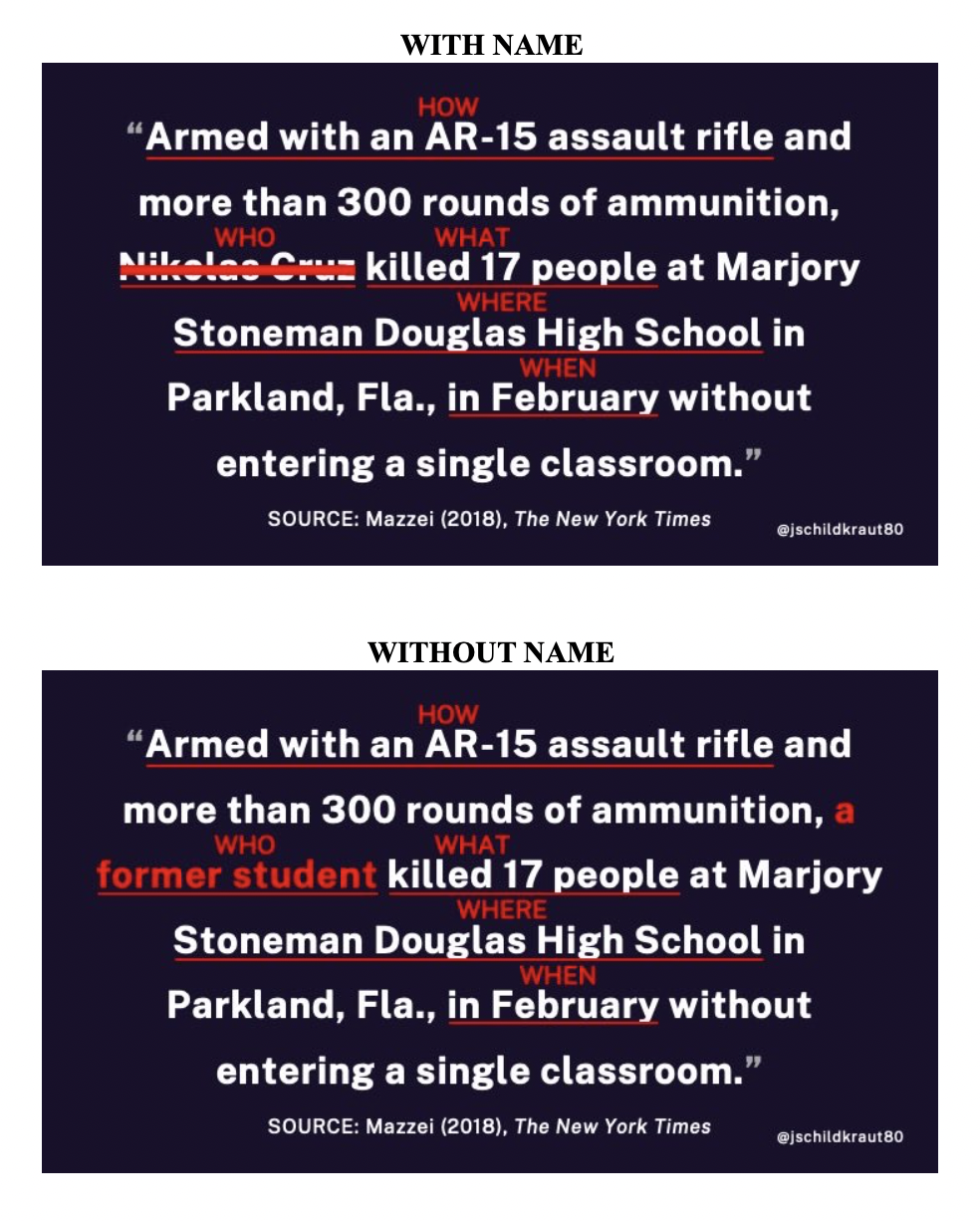
Why Mass Shooters Should Get No Notoriety
On Monday, July 4, 2022, people across the U.S. gathered to celebrate the nation’s independence with the usual pomp and circumstance – parades, fireworks, and other festivities. For one community, however, this time for celebration quickly became a nightmare.
As residents of Highland Park, IL, a suburban community located just 30 minutes north of Chicago, enjoyed the parade traveling through the downtown area, a lone gunman opened fire on the crowd from atop one of the buildings along the route. Within minutes, five people lay dead (two additional people later succumbed to their injuries at the hospital) and more than two dozen others were injured by gunfire. The perpetrator fled the scene and was apprehended by police nine hours later.
In the hours and days after the shooting, two divergent storylines emerged. The first – in almost predictable fashion – was about the perpetrator: a 21-year-old male (whose name I will not say) with a history of warning signs, including making both homicidal and suicidal threats. The routine armchair psychologizing of him also began nearly instantly: He was a loner. He played too many violent video games. The list goes on.
The second storyline was about Aiden McCarthy, a two-year-old who attended the parade with his parents, Kevin and Irina. When the shooting erupted, Kevin used his body to shield Aiden from the bullets. Both he and Irina were killed in the attack. Aiden, now an orphan, was found under his father’s body by residents trying to help the victims and was soon reunited with his grandparents. In less than 48 hours, people from across the nation and the world had donated more than $2.5 million to help support Aiden’s future all while knowing that no amount of money would replace the parents this little boy would never really know.
One event. Two completely different narratives. Which one should we prioritize?
Certainly, the answer to that should be simple, but the reality is far more complex because the way in which mass shootings have been covered since (and including) Columbine has set a dangerous precedent.
A Desire for Fame and Notoriety
While there is considerable variability among the perpetrators (outside of most likely being male and using a firearm), one thing that many have in common is their desire to be famous and have their story be known. The Columbine perpetrators mused about which blockbuster movie giant – Steven Spielberg or Quentin Tarantino – would direct their story. The Parkland perpetrator noted in a video left behind that everyone would know who he was when they saw him on the news.
Researchers have found mass shootings to be contagious. The occurrence of a mass shooting increases the likelihood that similar events will happen in the two weeks following the attack. In the 30 days following the Parkland shooting, for example, threats and incidents of violence in U.S. schools increased 300% over the 108 school days before it. The majority of these incidents came within the first two weeks after the shooting, when news coverage also was the highest.
While contagion periods are often shorter in nature, there also is evidence for a longer-term copycat effect. Research from Mark Follman and colleagues at Mother Jones, for instance, found that between 1999 and 2015, at least 74 plots or attacks modeled off the Columbine shooting were discovered. The 21 attacks that came to fruition left 89 dead and 126 wounded. Even more than 23 years after Columbine, perpetrators continue to reference the shooting.
It bears noting that not all mass shootings receive equitable attention by the media. Oftentimes, the coverage of these events is skewed toward the most extreme – and most lethal – incidents and those that deviate from what society has deemed as the “norm.” In fact, some of this coverage is so extensive that its value outpaces similar media attention devoted to popular celebrities and athletes. One study found that media coverage of the 2016 Pulse Nightclub shooting perpetrator was valued higher than the coverage for celebrities Chris Rock and Johnny Depp over the same amount of time ($5.3 million compared to $4.4 million and $3.7 million, respectively).
What are the consequences that arise from this pervasive media attention? Simply put, there are two significant concerns that we must be aware of. First, devoting excessive media attention to these shootings effectively rewards perpetrators for murdering other people. They tell us they want to be famous and that is what they get when they carry out their acts. Second, it incentivizes like-minded individuals who also seek fame to carry out similar attacks under the belief that they too will reap similar rewards. To that avail, it also incentivizes perpetrators to seek higher casualty counts under the believe they will get more attention.
Taken together, this raises an important question that must be answered: How do we stop incentivizing mass shooters? It turns out that the solution is already available.
No Notoriety
The No Notoriety movement began following the July 20, 2012, mass shooting at an Aurora, CO movie theater. Founded by Tom and Caren Teves, whose son Alex was among the 12 murdered at the venue, the No Notoriety mission is simple – deny mass shooting perpetrators the infamy they are seeking.
To accomplish this, journalists are encouraged to limit the use of the perpetrator’s name (once per story as a reference point) and image, avoiding prominent placement such as in headlines and above newspaper folds. Instead of highlighting the perpetrator, focus instead should be given to elevating the stories of the victims, survivors, and heroes. The media also should avoid publishing any manifestos, videos, photos, or legacy tokens that could serve to glorify the individual or their act or inspire other would-be assailants.
There are, of course, instances where sharing the perpetrator’s information is necessary. As noted, the Highland Park perpetrator remained at large for nearly nine hours after the shooting. Sharing his photo and name as much as possible was a matter of public safety as he was armed and dangerous. Once in custody, however, the shift to the No Notoriety protocol should be a priority.
In the early days of No Notoriety, few stations had adopted the guidance and the public even rallied against it. Two notable arguments against the protocol were a violation of the First Amendment’s guarantee of freedom of the press and the public’s right to know.
Regarding the first, the No Notoriety protocol was never designed to silence the press but instead to encourage a more responsible approach to covering these tragedies. In fact, the No Notoriety protocol closely mirrors guidance from the World Health Organization for covering suicide, which has been adopted by journalists across the globe. Suicide has been found to be a similarly contagious behavior. Following the 2014 death of actor Robin Williams, for example, the national suicide rate rose nearly 10 percent and suicides by asphyxiation (the same manner in which he died) increased more than 32 percent in five months. Thus, given the parallels, a widespread adoption of similar guidelines related to the coverage of mass shootings is warranted.
While the public may have a right to know, it also has a responsibility to help take any precautions to prevent mass shootings and other forms of violence. Despite commentary to the contrary, removing the perpetrator’s name does not change the story. In fact, replacing a given name with “the perpetrator” or an equally banal term does not eliminate the “5Ws (and an H)” of a story.
Take for example this excerpt of a news story published in The New York Times following the Parkland shooting.
Here, replacing the perpetrator’s name with a generalized description of him does not change the meaning of the statement, but it does serve to remove his identity and deny him the notoriety.
Gaining Momentum
At a press conference following the May 14, 2022, mass shooting at the Tops Supermarket in Buffalo, NY, which left 10 dead, 3 injured, and a community devastated, Erie County Sheriff John Garcia declined to speak the perpetrator’s name. “As far as we’re concerned, he’s Inmate Control Number 157103,” he said in his statement. Although the perpetrator’s identity was made known in the media shortly thereafter, neither Sheriff Garcia nor others investigating the attack ever spoke his name.
Both before and since the Buffalo shooting, the push for No Notoriety has been apparent. More news stations, particularly those in affected communities, are refusing to say the name of perpetrators. More members of the public are calling for responsible reporting, asking that news outlets not show the perpetrators’ photos or use their names.
Although the use of No Notoriety will not guarantee that we will eradicate mass shootings, it is an important first step that can be taken – one that doesn’t require bipartisan support to get implemented. We know what mass shooters want, and we must stop giving it to them.
Jaclyn Schildkraut is an associate professor of Criminal Justice at SUNY Oswego and the interim executive director of the Regional Gun Violence Research Consortium at the Rockefeller Institute of Government. She is also a national expert on mass shootings and school safety.


